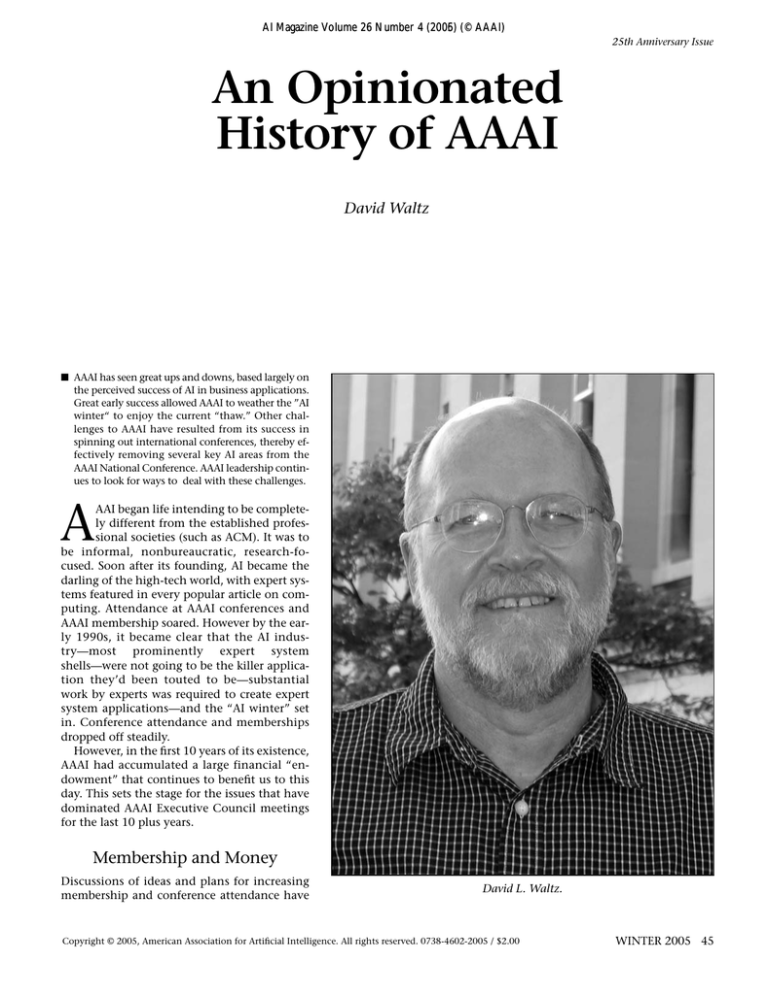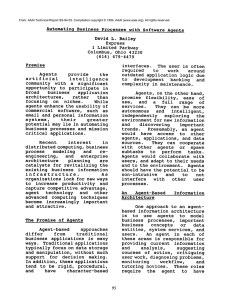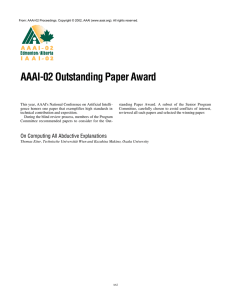
AI Magazine Volume 26 Number 4 (2005)
(2006) (© AAAI)
25th Anniversary Issue
An Opinionated
History of AAAI
David Waltz
■ AAAI has seen great ups and downs, based largely on
the perceived success of AI in business applications.
Great early success allowed AAAI to weather the ”AI
winter“ to enjoy the current “thaw.” Other challenges to AAAI have resulted from its success in
spinning out international conferences, thereby effectively removing several key AI areas from the
AAAI National Conference. AAAI leadership continues to look for ways to deal with these challenges.
A
AAI began life intending to be completely different from the established professional societies (such as ACM). It was to
be informal, nonbureaucratic, research-focused. Soon after its founding, AI became the
darling of the high-tech world, with expert systems featured in every popular article on computing. Attendance at AAAI conferences and
AAAI membership soared. However by the early 1990s, it became clear that the AI industry—most prominently expert system
shells—were not going to be the killer application they’d been touted to be—substantial
work by experts was required to create expert
system applications—and the “AI winter” set
in. Conference attendance and memberships
dropped off steadily.
However, in the first 10 years of its existence,
AAAI had accumulated a large financial “endowment” that continues to benefit us to this
day. This sets the stage for the issues that have
dominated AAAI Executive Council meetings
for the last 10 plus years.
Membership and Money
Discussions of ideas and plans for increasing
membership and conference attendance have
David L. Waltz.
Copyright © 2005, American Association for Artificial Intelligence. All rights reserved. 0738-4602-2005 / $2.00
WINTER 2005 45
25th Anniversary Issue
Waltz Delivered His Presidential Address at the Fifteenth National Conference on
Artificial Intelligence (AAAI-98) in Madison, Wisconsin.
been staples of AAAI Executive Council meetings from the early 1990s until today. There has
been a tension between those who want to protect the “endowment” by keeping expenditures
down and those who argue that AAAI should
expend its funds on items that could serve as
investments in the future, for example by
sponsoring (expensive) robot competitions to
bring young people into AI. It proved so difficult to stop the membership and conference attendance slide that some defeatists facetiously
suggested closing up AAAI and distributing the
funds to the remaining members as a tontine.
On the positive side, AAAI’s assets have been
well allocated, and the “endowment” benefited
greatly from the stock market run-ups of the
1990s. Each year the late Norm Nielsen, longtime AAAI treasurer, would warn of the need to
conserve funds for a rainy day; each year, despite generous expenditures on AAAI activities,
the “endowment” increased, making his warnings sound overly cautious. While hit by the
46
AI MAGAZINE
market downturn of the early 2000s, AAAI’s
war chest is still sizable. And recently conference attendance has leveled off and turned up.
Spinning off
Conferences and Subfields
AAAI has spun off conferences at a steady rate,
paralleling AI’s shedding of subfields. The most
notable defection was the knowledge discovery
and data mining conference (KDD), but many
research areas that had traditionally viewed the
AAAI conferences as key venues moved away
from the AAAI conference and AAAI sponsorship over the years—natural language processing, vision, KR, robotics, learning, and so on.
There are three main reasons for the exodus:
first, subfields have become large enough and
specialized enough that they could support
quite large separate conferences; second, attendees preferred conferences that concentrated
25th Anniversary Issue
on topics of direct interest, unlike the very
broad AAAI conference; and third, the subfields
saw themselves as international and didn’t
want to be organizational subparts of an American professional society. There have been a
number of ideas about how to keep relationships with these areas, the most prominent and
successful being collocation of their conferences with AAAI. AAAI has explored the possibility of becoming an international AI society
(“Association for the Advancement of AI”)—for
example by consolidating with non-U.S. societies—but this is a sensitive issue, since so
many countries have their own national AI societies with proud independent histories, and
AAAI is inherently averse to pressure politics
and cultural imperialism.
We as a field have long bemoaned the splintering of AI into subfields that over the years
create more and more specialized technologies
and mutually incomprehensible technical languages. AAAI has tried to encourage bridges between the current and former parts of AI by
inviting articulate distinguished speakers from
splintered fields, by scheduling sessions that
summarize trends and breakthroughs from
splintered conferences, and so forth. Ron
Brachman, in his presidential address at AAAI05, presented the first really novel idea I’ve
heard in a long time for bringing the subareas
back together: Ron argued that the subfields are
now fairly mature and that we can now consider intelligent architectures that include all the
pieces in one collaborating system. This requires joint discussion, planning, and system
building. It remains to be seen whether this
idea will lead to a reunification of AI or
whether it can be used to rejuvenate AAAI conferences.
reflected in the greater success rates for theoretical versus applied fellow nominees. (This is in
no way meant to suggest that any fellows are
not worthy—merely that it’s proven harder to
get even strong applications-oriented candidates
elected.) One personal comment: I feel that related factors tend to favor the selection of people who are strong in a well-developed subfield
versus innovators and iconoclasts who are
equally strong (for example, as measured by
publication impact). In recent years I and others
have raised these points with the Fellows Selection Committee, and I have reason to believe
that we will see changes (I’d say improvements)
in future years.
Prospects
I think it’s likely that AI is entering a new golden age. The AI winter is a distant memory, totally eclipsed by the more recent bursting of
the tech bubble, an event whose lasting impact
is itself fading. The web has been a great source
of applications and data, and AI is putting a
strong mark on the web (for example, the semantic web and web applications that learn
and adapt). But beyond the web, the availability of incredibly cheap and powerful computing and memory is making an ever wider range
of computationally expensive AI applications
practical. Many applications long demonstrable in principle (such as speech understanding
and vision for control of vehicles) can now be
done cheaply and in real time. Learning applications, especially in data mining and data
analysis, are helping AI ideas to spread widely
into other fields and, in the process, bringing
ideas from those fields back into AI (for example, from statistics and systems security). I believe AI’s (and AAAI’s) best days lie before us.
Theory Versus Application
Acknowledgements
The key effect of the spin-offs of subfields has
been that AAAI has tended to retain AI theory,
giving theory a greater representation in AAAI
than it has in the field as a whole, measured by
all those who say they’re doing AI in universities, companies, and government. A minority
but vociferous faction within AAAI has tried to
counterbalance this trend by celebrating applications, most notably in the IAAI conferences.
The net result is that, taken together, AAAI and
IAAI have their greatest strengths at the extremes of theory and practice (albeit with
much greater weight at the theory extreme),
while much of the AI mainstream goes elsewhere.
This issue also surfaces in the selection of fellows. The preponderance of theorists in AAAI is
Many thanks to Jim Hendler and David Leake
for their insightful comments and suggestions.
David L. Waltz is director of the Center for
Computational Learning Systems at Columbia
University. He was formerly president of the
NEC Research Institute in Princeton and from
1984–93, was director of advanced information
systems at Thinking Machines Corporation
and professor of computer science at Brandeis
University. He was also a professor at the University of Illinois for 11 years. Waltz completed
his Ph.D. at the Massachusetts Institute of
Technology, is a Fellow of ACM and AAAI, and
served as president of AAAI from 1997–99.
WINTER 2005 47





